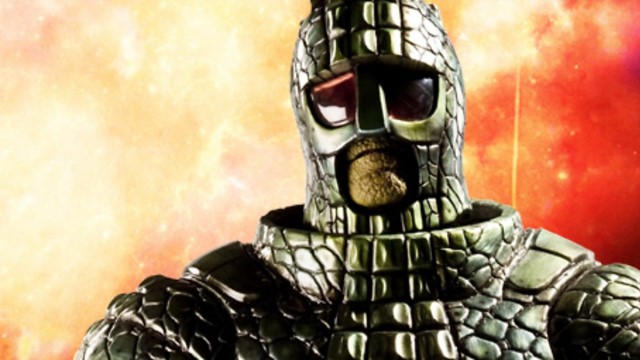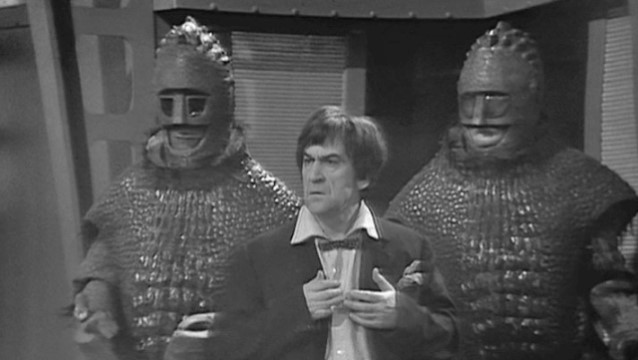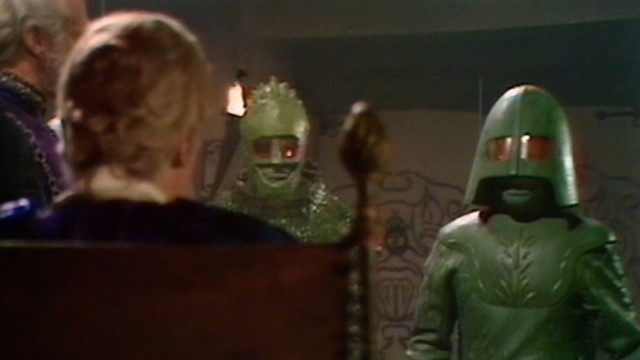The Ice Warriors are one of Doctor Who‘s most complex alien races – morally grey, even if they’re literally green…

First and foremost, the most important thing to know about the Ice Warriors is that, well, they’re not called Ice Warriors. Not for the last time in Doctor Who, the original Ice Warriors serial (and the aliens themselves) referred to a nickname made up by a human observer. But when Brittanicus Base crewman Walters declares the frozen body found in the glacier a “proper ice warrior,” it was a title that stuck through all their later appearances, even when there wasn’t as much as light dusting of snow to be found.
In reality, the so-called Ice Warriors are the once and future Martians, residents of Mars in its ancient past when it was still inhabitable, and who we know will one day reclaim it. Strangely, we never see the Ice Warriors’ civilization on Mars at its height on television. But as we’ll see there are other ways to involve them in a story.
The Ice Warriors’ first appearance was, naturally enough, in ‘The Ice Warriors.’ The ecologically minded story from 1967 sees the Second Doctor and his friends Jamie and Victoria land on Earth in the future, as humanity attempts to mitigate the devastating climate change their own destruction of the rain forests has caused. It would be eerily prescient if not for the little mistake of thinking such action would make the climate much colder, not warmer…
The ‘Ice Warrior’ moniker would also go on to cause some confusion in their later appearances, with them associated with ice and, despite being reptiles, thriving in cold, not heat.
In their first appearance the Ice Warriors are only on Earth by accident, initially wanting only to escape
As glaciers advance in a new Ice Age that threatens to destroy the cities of northern Europe, the team at Brittanicus Base use a giant ioniser to push the ice back. But their task is complicated by the discovery of mysterious figures in the glacier – aliens who, it soon transpires, also have their spaceship trapped under the ice. It paralyzes the base leader, Clent, as he frets about the potential explosion of the alien engines if hit by the ioniser.
Created by writer Brian Hayles, the Ice Warriors were based on several real life examples of ancient people and extinct animals like mammoths being found preserved in the colder parts of the world and by news stories of archaeologists hoping to find frozen ice mummy Vikings one day. Appropriately, Hayles originally conceived his Martians as resembling Vikings, with only the Doctor noticing the cybernetic implants and weapons beneath the ice that hinted at their real origins. But designer Martin Baugh and producer Peter Bryant, always on the look out for the “next Daleks,” decided on a more fearsome monster like an armoured upright crocodile.
Bernard Bresslaw, the 6’7″ (2m) actor best known for his comedy roles as clumsy man-children in films like the Carry On series, was cast as the lead Ice Warrior. His imposing height and sinister hissing whisper created the template for other actors to follow. Meanwhile the cautious, tactical character he created – ruthless, but not sadistic – would create the space for the race to evolve into something more than just physically powerful monsters.
These first Ice Warriors we meet have come to our planet quite by accident. Crashing into the Arctic 5,000 years ago they’ve been in hibernation ever since until disturbed by the humans. Their leader Varga is originally determined to do whatever is necessary to get their ship back into space and his men back home. But when he learns that Mars is now a dead world, he refuses the Doctor’s suggestions of adapting to life on Earth as refugees. Instead, Varga seizes on a dream of conquering our world and making it a new Mars.

The Ice Warriors’ modern appearances reveal many of their secrets, but maintain the sense of warlike nobility
It’s a dream shared by Slaar in the following season’s ‘The Seeds of Death.’ This time the Doctor doesn’t just have to contend with an isolated band of lost warriors, but an entire space armada hell bent on making 22nd century Earth their new home. And they’ve made a start by hijacking the planet’s own teleport network to distribute their terraforming seeds around the world to change our atmosphere into one suitable for them, not us. Naturally, with the Doctor around, the plan fails.
Skipping ahead to Doctor Who’s 50th anniversary year, Matt Smith’s final series appropriately revisited some old favourites. These included Mark Gatiss’ ‘Cold War,’ and its Grand Marshal Skaldaak. Like Varga and his crew, Skaldaak has been frozen in the ice for 5,000 years, but unlike them he awakens to find himself on a Soviet nuclear submarine in 1983. From there, the story echoes some aspects of the Martians’ first appearance. Skaldaak attempts to use his homing beacon to summon rescue from Mars but grows despondent when he realises his homeworld has died as he slept.
However, Skaldaak is presented as a more rounded character than those before him. He dwells on the deaths of his family, and particularly his daughter. And his decision to commandeer the submarine’s nuclear missiles to start World War III and end the human race is more about his personal anguish than his code of honour. We also finally get a definitive answer about the Ice Warriors’ armour.
It was always difficult to tell where alien ended and armour began, but ‘Cold War’ reveals the entire thing is a mechanised suit for a much spindlier, more agile, creature within. And Gatiss also tidily patches the long standing question of why these reptiles hate heat; the armour is designed to protect them from the cold but sudden increases in temperature confuses its internal thermostat.
‘Empress of Mars,’ surprisingly, gives us our first sight of the Martian warriors on the red planet itself
Peter Capaldi becomes the first Doctor to meet the Ice Warriors on their home turf in ‘Empress of Mars’ as he and Clara travel to Mars in 1881 and discover British redcoats impossibly there before them. Gatiss’ latest storyline was important in two ways. First, it marked the first time we saw a female Martian on screen, as well as clearly establishing that they’re ruled by royal dynasties, such as Empress Iraxxa of Mars who we meet in the episode.
Second, the story ends with first contact between Mars and Alpha Centuri, representing the wider peoples of the universe. From this point on, the Ice Warriors become part of something much larger than themselves.
Both ‘Cold War’ and ‘Empress of Mars’ lean heavily on the idea that the Ice Warriors are noble warriors: Fearsome in battle and merciless to their enemies, but with their own moral code that makes them possible to reason with. Along with the Silurians and Sea Devils, it makes them rarities in the Doctor Who universe. When the Ice Warriors arrive, you never quite know what’s going to happen.

The Ice Warriors’ 1970s appearances reveal that in the distant future they will become key members of the Galactic Federation
The Martians’ unpredictability is never clearer than in ‘The Curse of Peladon.’ Moving back in time to the 1972 serial starring Jon Pertwee as the Doctor, we meet the Ice Lord Izylr and his bodyguard Ssorg. The two are among the delegation from the Galactic Federation to the medieval planet of Peladon, helping negotiate its entry into the interstellar community of planets. And when people begin to die, and omens and portents of the legendary beast Aggedor threaten to ruin the treaty, the Doctor doesn’t have far to look for his prime suspects.
But in fact, while the Doctor is investigating them, the Ice Warriors are investigating him as the likely culprit. We learn that Mars has been reclaimed and rebuilt by the descendants of its ancient people, and that the Federation has no more loyal members, or fierce defenders, than the Ice Warriors. And once their misunderstandings are put behind them, the Doctor has no better ally in his search for the real killers. What we didn’t know at the time is the Doctor’s own role in their presence. After all, it’s the Twelfth Doctor who calls in Federation delegate Alpha Centuri to help the Martians relocate across the universe in ‘Empress of Mars.’
Two years later, the Third Doctor and the Ice Warriors were back for the sequel ‘The Monster of Peladon.’ 50 years have passed: A new generation of Peladonian nobles and Martian delegates (Azaxyr and Sskel) are embroiled in intrigue surrounding Peladon’s vital role the battle against Galaxy Five. There’s more sabotage, murder and arcane prophecies, and even a miner’s strike. And just to keep audiences on their toes, this time the Ice Warriors really are behind it.
Though it’s revealed that Azaxyr is part of a renegade splinter group pushing to return to the old ways of glorious conquest, it still reveals a new wrinkle to the aliens. We’ve never seen the Ice Warriors use manipulation and deception as weapons before, or since. But, it seems, a Martian who has abandoned honour is capable of anything.
The Ice Warriors have a wide life beyond the television screen; we even David Tennant and Billie Piper getting a chance to do battle with them on audio
The Ice Warriors have had six television appearances across six decades, but like all iconic Doctor Who monsters, they’ve had dozens more in other media. Thanks to Big Finish, yet more Doctors have confronted them on audio, from Peter Davison to David Tennant. Some of these stories stick close to the original format, like ‘God of War,’ in which the Fifth Doctor discovers a Viking settlement worshiping a risen Ice Warrior as the Norse god Tyr. Others echo the later Peladon stories, like ‘Cry of the Vultriss,’ with planets making first contact with Ice Warriors who are galactic ambassadors.
Some push the format further, like ‘The Judgement of Isskar,’ which is set before the founding of the Ice Warrior military society we know, or ‘Deimos / The Resurrection of Mars,’ where humans have foolishly turned the ancient Martian tombs into a tourist attraction.
And notably, ‘Cold Vengeance’ successfully reunites David Tennant and Billie Piper as the Tenth Doctor and Rose meet the Ice Warriors on a satellite in the future. Meanwhile, in ‘UNIT: Fire and Ice,’ Kate Stewart, Osgood, and their team try to negotiate a ceasefire with an elite Ice Warrior death squad on Earth looking for a fugitive from Martian justice.
The ‘Lost’ Stories ‘Lords of the Red Planet,’ ‘Mission to Magnus,’ and ‘Thin Ice’ are particularly special in reviving scripts for the Second, Sixth, and Seventh Doctors respectively which were originally intended for TV. In prose, too, there are no fewer than 14 original novels featuring further meetings between the Doctor and the armoured reptiles. And that’s not even counting the Doctorless spin-off volumes or short stories! Though ‘The Dying Days’ earns special notice as the first original novel to feature Paul McGann’s Eighth Doctor after the 1996 TV Movie, with the newly regenerated Doctor grappling with a Martian invasion of Earth that prefigures events in ‘The Christmas Invasion.’
Like so many of the great Doctor Who monsters, completing a tour of the Ice Warriors’ escapades across all media is almost as large a task as watching all of Doctor Who itself on television. With their almost singular moral complexity allowing them to switch from heroes to villains, and to something in between, they’re a race that merits further TV appearances. But for now, the secret of if (and when) that might be is locked in the mind of Russell T Davies.
But which are your favourite Ice Warrior episodes, books or audios so far? And would you like to see them return in Series 14? Let me know in the comments below.

Doctor Who TARDIS Laptop Bag – order now from the Lovarzi shop!


Leave a Reply